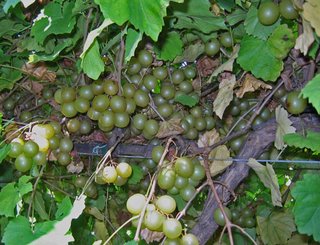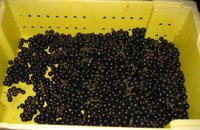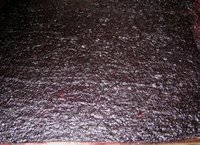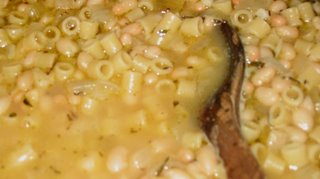Capers
For this weekend's Weekend Herb Blogging, well last weeks, I mean, I'm all about capers.

According to The New Food Lover's Companion by Sharon Tyler Herbst:
caper [KAY-per] The flower bud of a bush native to the Mediterranean and parts of Asia. The small buds are picked, sun-dried and then pickled in a vinegar BRINE. Capers range in size from the petite nonpareil variety from southern France (considered the finest), to those from Italy, which can be as large as the tip of your little finger. There are also the Spanish-imported stemmed caperberries that
are about the size of a cocktail olive. Capers are generally packed in brine but can also be found salted and sold in bulk. Capers should be rinsed before using to remove excess salt. The pungent flavor of capers lends piquancy to many sauces and condiments; they're also used as a garnish for meat and vegetable dishes.
Two of my favorite ways of using them are first in olive tapenade. My recipe is on the website. Swank Recipes I sometimes make it finely ground with black olives only, but lately, I have been mixing good Greek olives with good green olives as well as Manzanella's stuffed with pimentos and grinding them coarse to get a unique flavor with good color and serving them as a side with tuna and pita points. Very good.

My other favorite way to cook them is with Chicken Piccata. This is my recipe:

Chicken Piccata
Serves 4
1 large lemon
4 boneless, skinless chicken breasts (5 to 6 ounces each), tenderloins removed and reserved for another use, fat trimmed, pounded.
Salt and ground black pepper
1/2 cup unbleached all-purpose flour
4 tablespoons olive oil
1 small shallot, minced (about 2 tablespoons) and 1 small clove garlic, (about 1 teaspoon)
1/4 cup white wine
1 cup homemade chicken stock or canned low-sodium chicken broth
2 tablespoons drained small capers
3 tablespoons unsalted butter, softened
2 tablespoons minced fresh parsley leaves
Halve one lemon. Juice the whole lemon to obtain 1/4 cup juice; reserve.
Sprinkle both sides of the cutlets generously with salt and pepper. Measure the flour into a shallow baking dish or pie plate. Working with one cutlet at a time, coat with the flour and shake to remove the excess.
Heat 2 tablespoons oil in a heavy-bottomed 12-inch skillet over medium-high heat.
Lay half of the chicken cutlets in the skillet. Sauté the cutlets until lightly browned on the first side, 2 to 3 minutes. Turn the cutlets and cook until the second side is lightly browned, 2 to 3 minutes longer. Remove the pan from the heat and transfer the cutlets to the plate. Add the remaining 2 tablespoons oil to the now-empty skillet and heat. Add the remaining chicken cutlets and repeat.
Add the shallot to the now-empty skillet and return the skillet to medium heat. Sauté until fragrant, about 30 seconds for shallot then add garlic for about 10 seconds. Add the wine then add the stock, increase the heat to high, and scrape the pan bottom with a wooden spoon or spatula to loosen the browned bits. Simmer until the liquid reduces, about 4 minutes. Add the lemon juice and capers and simmer until the sauce reduces again, about 1 minute. Remove the pan from the heat and swirl in the butter until the butter melts and thickens the sauce. Stir in the parsley and season with salt and pepper to taste. Spoon the sauce over the chicken and serve immediately. An extra lemon can be sliced and added to the pan with the wine and broth.
We're getting behind and have lots of cooking to do. Enjoy the rest of the beautiful weekend! Cheers















